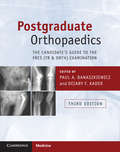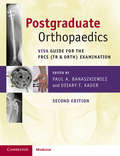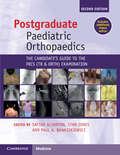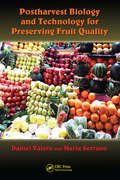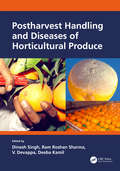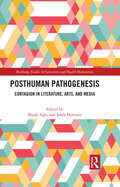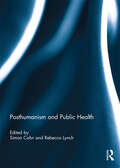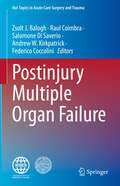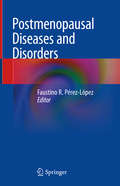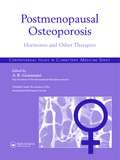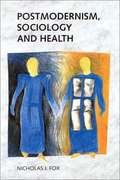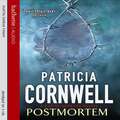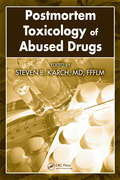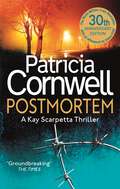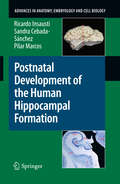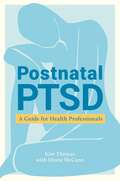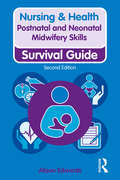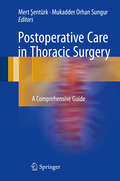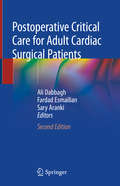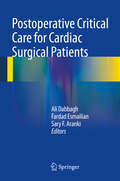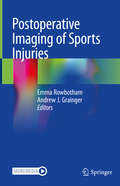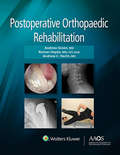- Table View
- List View
Postgraduate Orthopaedics: Mcqs and Emqs for the Frcs (Tr & Orth)
by Kesavan Sri-RamWhat do you need to do before sitting the written component of the FRCS (Tr and Orth) examination? Practice, practice, practice. Sadly the MCQs and EMQs in the actual examination are not this straightforward. This book will help the orthopaedic surgeon preparing for the written part of the examination to be ready to face the task ahead. The MCQs and EMQs appear in the same format as the examination and cover the syllabus topics. Divided into subspecialty chapters, including trauma and basic science, this book is ideal for use alongside a revision plan. The questions have detailed answers and selected references, arming readers with the knowledge they need to approach the topic correctly. Written by recent, successful examination candidates, this question-and-answer-based revision guide is ideal preparation for the FRCS (Tr and Orth) examination as well as being helpful for other postgraduate orthopaedic exams.
Postgraduate Orthopaedics: The Candidate's Guide To The Frcs (tr And Orth) Examination
by Paul A. Banaszkiewicz Kader Deiary F.This book has been written specifically for candidates sitting the oral part of the FRCS (Tr & Orth) examination. It presents a selection of questions arising from common clinical scenarios along with detailed model answers. The emphasis is on current concepts, evidence-based medicine and major exam topics. Edited by the team behind the successful Candidate's Guide to the FRCS (Tr & Orth) Examination, the book is structured according to the four major sections of the examination; adult elective orthopaedics, trauma, children's/hands and upper limb and applied basic science. An introductory section gives general exam guidance and end section covers common diagrams that you may be asked to draw out. Each chapter is written by a recent (successful) examination candidate and the style of each reflects the author's experience and their opinions on the best tactics for first-time success. If you are facing the FRCS (Tr & Orth) you need this book.
Postgraduate Orthopaedics: Viva Guide for the FRCS (Tr & Orth) Examination
by Banaszkiewicz Kader Paul A. Frcs Glas Frcs Ed Frcs Eng Fr Tr Orth) MClinEd FAcadMEd FHEA Deiary F. Frcs Glas Frcs Ed Frcs Tr Orth MfsemDevelop an aptitude for defining key topics, features and processes, vital for your FRCS (Tr&Orth) Viva exam success, with this newly updated and detailed guide. This new edition expertly delivers invaluable insights into tactics and planning, for candidates to sharpen exam skills, and gain confidence. Thoroughly updated to include an expanded basic science section, to answer all of your viva questions, this guide also supplies candidates with new illustrations and exam-specific diagrams; adapting to meet the expectations of a constantly changing syllabus. Vital for orthopaedic surgeons in training, this forward-looking text includes a drawing chapter, for candidates to practise creating succinct, exam-style illustrations, before the exam itself. Proactive in its approach, this book addresses the balance between trauma, general orthopaedics and basic science; by editors with extensive national and international experience of preparing candidates for the FRCS(Tr & Orth).
Postgraduate Paediatric Orthopaedics: The Candidate's Guide To The Frcs (tr And Orth) Examination
by Stan Jones Paul A. Banaszkiewicz Sattar AlshrydaPostharvest Biology and Technology for Preserving Fruit Quality
by Daniel Valero Maria SerranoInterest in the postharvest behavior of fruits and vegetables has a history as long as mankind's. Once we moved past mere survival, the goal of postharvest preservation research became learning how to balance consumer satisfaction with quantity and quality while also preserving nutritional quality. A comprehensive overview of new postharvest techno
Postharvest Handling and Diseases of Horticultural Produce
by Dinesh SinghPostharvest Handling and Diseases of Horticultural Produce describes all the postharvest techniques, handling, pre-cooling, postharvest treatment, edible coating and storage of the horticultural produce available to handle perishable horticultural food commodities, covering the areas of horticulture, agricultural process engineering, postharvest technology, plant pathology and microbiology. Postharvest diseases of major fruits and vegetables, with their causal agents, are described. The integrative strategies for management of postharvest diseases include effectively inhibiting the growth of pathogens, enhancing the resistance of hosts and improving environmental conditions, with results that are favourable to the host and unfavourable to the pathogen growth including biotechnological approaches. Adopting a thematic style, chapters are organized by type of treatment, with sections devoted to postharvest risk factors and their amelioration. The chapters are written by experts in the fields of plant pathology, horticulture, food science etc., and core insights into identifying and utilizing appropriate postharvest options for minimizing postharvest losses and enhancing benefits to end-users are provided. Features Presents the most recent developments in the field of postharvest handling technologies and diseases in a single volume Includes postharvest diseases of cut flowers, fruits, vegetables and tuber crops. Appropriate for students, researchers and professionals Written by experts and can be used as a reference resource
Posthuman Pathogenesis: Contagion in Literature, Arts, and Media (Routledge Studies in Literature and Health Humanities)
by Başak AğınThis multi-vocal assemblage of literary and cultural responses to contagions provides insights into the companionship of posthumanities, environmental humanities, and medical humanities to shed light on how we deal with complex issues like communicable diseases in contemporary times. Examining imaginary and real contagions, ranging from Jeep and SHEVA to plague, HIV/AIDS, and COVID-19, Posthuman Pathogenesis discusses the inextricable links between nature and culture, matter and meaning-making practices, and the human and the nonhuman. Dissecting pathogenic nonhuman bodies in their interactions with their human counterparts and the environment, the authors of this volume raise their diverse voices with two primary aims: to analyse how contagions trigger a drive to survival, and chaotic, liberating, and captivating impulses, and to focus on the viral interpolations in socio-political and environmental systems as a meeting point of science, technology, and fiction, blending social reality and myth. Following the premises of the post-qualitative turn and presenting a differentiated experience of contagion, this ‘rhizomatic’ compilation thus offers a non-hierarchised array of essays, composed of a multiplicity of genders, geographies, and generations.
Posthumanism and Public Health
by Posthumanism and Public HealthThe intellectual and moral imperatives that underscore public health have sustained the idea that its fundamental scope is the study of human health, illness and suffering, and that these are self-evidently attributable to individuals and groups of people. This edited collection explores to what extent a shift towards more posthuman perspectives – where the status of the human as the obvious focus for our attention is de-stabilised – might catalyse complimentary or alternative accounts of common topics in public health. The collection argues that through this posthuman approach, standard categories such as health, illness and even the body might be re-conceived as interactions between different entities – between people, other living things, material objects and the environment – rather than as inherently human properties. By taking into greater account non-humans and relationships between humans and non-humans, this approach offers a re-casting of traditional topics in public health and opens new opportunities for examining these. In so doing, the book raises key questions about researching ‘health’; about considering the extent to which it may be productive to think about health as it interests not only human lives; and what happens to our moral and ethical commitments if we no longer put humans first. This book was originally published as a special issue of Critical Public Health.
Postinjury Multiple Organ Failure (Hot Topics in Acute Care Surgery and Trauma)
by Raul Coimbra Salomone Di Saverio Federico Coccolini Andrew W. Kirkpatrick Zsolt J. BaloghThis book on post-injury multiple organ failure (MOF) offers a comprehensive overview and clinically focused practical guide to treating the condition. MOF is arguably the most difficult complication to manage in polytrauma patients and is responsible for the majority of trauma deaths among patients who survived the first 24 hours after injury. Beyond mortality, it has a major impact on healthcare resource utilization and a persistent negative effect on patients’ long-term reported outcomes. This book is edited by surgeons who are passionate about the topic, and about optimizing the outcomes for polytrauma patients. Grasping the fascinating pathophysiology of MOF is essential for providing patients with quality early care. Each chapter highlights key learning objectives, historical perspectives, diagnostic and therapeutic pearls, and includes a must-know summary, additional reading suggestions and future research directions. Flowcharts, decision-making guides, summary tables, graphics and clinical photographs help to maximize the learning experience and to ensure readers retain what they’ve learned. The book fills a unique niche area for many specialties dedicated to critical care of polytrauma patients and to their management before and beyond intensive care.
Postmenopausal Diseases and Disorders
by Faustino R. Pérez-LópezSupported by the latest scientific data, this book serves as a guide to the clinical assessment of women’s health during the second half of life (post-reproductive years), including approaches to the management of the most frequent age-related diseases and disorders and the most recent advances in treatment. In addition, it discusses preventive aspects of healthcare in post-reproductive women, identifying lifestyle measures to enhance healthy aging. By highlighting research gaps, it promotes the development of quick and easy-to-use assessment tools and predictive markers of age-related co-morbidities. As such, the book is a valuable resource for researchers and clinicians alike.
Postmenopausal Osteoporosis: Hormones & Other Therapies
by Ken EasonThe book is the first major review of menopause-associated osteoporosis, post WHI. The book has in-depth sections on the pathogenesis, epidemiology, and diagnosis of osteoporosis. The chief focus is on medical prevention and treatment, and includes chapters on hormone replacement therapy, bisphosphonates, selective estrogen receptor modulators (SER
Postmodernism, Sociology and Health
by Nicholas J. FoxThe emergence of post-structuralism and postmodernism within social theory has challenged many of the fundamentals of modernist social science. The emphasis which these approaches place on language, firstly as the unavoidable mediator between an object of study and a description of that object, and secondly as something which is profoundly unstable, marks the broadest of these challenges -- to the possibility that sociology and the other human sciences might achieve rational knowledge of the world.
Postmortem (Kay Scarpetta #1)
by Patricia CornwellThe inspiration for the Prime Video series Scarpetta—starring Nicole Kidman and Jamie Lee Curtis! Discover the &“dazzling...fascinating&” (Los Angeles Times) novel that launched the popular Kay Scarpetta series, from the New York Times #1 bestselling crime writer Patricia Cornwell.Patricia Cornwell&’s debut novel Postmortem introduces one of crime fiction&’s most compelling characters: gutsy medical examiner Kay Scarpetta. Cornwell&’s gift for combining cutting-edge criminology with nerve-shattering suspense makes this book a true modern classic. Under cover of night in Richmond, Virginia, a monster strikes, leaving a gruesome trail of stranglings that has paralyzed the city. Kay Scarpetta suspects the worst: a deliberate campaign by a brilliant serial killer whose signature offers precious few clues. With an unerring eye, she calls on the latest advances in forensic research to unmask the madman. But this investigation will test Kay like no other, because it&’s being sabotaged from within—and someone wants her dead.
Postmortem (Kay Scarpetta)
by Patricia CornwellA serial killer is on the loose in Richmond, Virginia. Three women have died, brutalised and strangled in their own bedroom. There is no pattern: the killer appears to strike at random - but always early on Saturday mornings.So when Dr Kay Scarpetta, chief medical officer, is awakened at 2.33 am, she knows the news is bad: there is a fourth victim. And she fears now for those that will follow unless she can dig up new forensic evidence to aid the police.But not everyone is pleased to see a woman in this powerful job. Someone may even want to ruin her career and reputation ...
Postmortem Toxicology of Abused Drugs
by Steven B. KarchPostmortem Toxicology of Abused Drugs considers the role of toxicology in death investigation and gives practical insights on conducting toxicology tests and completing the toxicology report. It explains chain of custody; specimen collection and security; sampling of blood, urine, bile, and vitreous humor; and selection of post-mortem specimens. The book analyzes various testing procedures, discusses methods and strategies for analysis, covers quality assurance protocols and controls, and instructs in the proper interpretation of postmortem drug tests. Heavily referenced and containing several tables, figures, and useful appendices, this book is a handy reference for forensic scientists and medical examiners involved with death inves
Postmortem: Ein Kay-scarpetta-roman (Kay Scarpetta #1)
by Patricia CornwellThe first book in the Kay Scarpetta series, from No. 1 bestselling author Patricia Cornwell.'America's most chilling writer of crime fiction' The TimesA serial killer is on the loose in Richmond, Virginia. Three women have died, brutalised and strangled in their own bedroom. There is no pattern: the killer appears to strike at random - but always early on Saturday mornings. So when Dr Kay Scarpetta, chief medical officer, is awakened at 2.33 am, she knows the news is bad: there is a fourth victim. And she fears now for those that will follow unless she can dig up new forensic evidence to aid the police.But not everyone is pleased to see a woman in this powerful job. Someone may even want to ruin her career and reputation . . .Praise for the groundbreaking series:'One of the best crime writers writing today' Guardian'Devilishly clever' Sunday Times'The top gun in this field' Daily Telegraph'Forget the pretenders. Cornwell reigns' Mirror'The Agatha Christie of the DNA age' Express
Postnatal Development of the Human Hippocampal Formation
by Ricardo Insausti Sandra Cebada-Sánchez Pilar MarcosThis monograph intends to introduce the postnatal development of morphological features relevant to the reader interested in the neurobiology and pathology of the hippocampal formation in the complex phenomena underlying the progressive anatomical and functional maturation of this brain region. This review is focused in the morphological aspects, while more detailed basic phenomena of neuronal maturation, no doubt, of great interest, will be only marginally referred to, although a selection of behavioral and clinical aspects will be briefly addressed too as an attempt to illustrate real situations in different clinical specialties.
Postnatal PTSD: A Guide for Health Professionals
by Kim Thomas Shona McCannPostnatal PTSD, often referred to as birth trauma, is an underdiagnosed and misunderstood condition. Often mistaken for postnatal depression and with 4% of women developing the condition after giving birth, it is essential that health professionals learn to recognise and prevent postnatal PTSD.The book supports professionals to better understand, recognise, treat and help prevent birth trauma. It covers the impact of postnatal PTSD on bonding and relationships, birth trauma in Black, Asian and minority ethnic communities, how to support women having another baby and more.An accessible guide to supporting parents with postnatal PTSD, this book is essential reading for healthcare professionals and those involved with the birthing process.
Postnatal and Neonatal Midwifery Skills: Survival Guide (Nursing and Health Survival Guides)
by Alison EdwardsThis pocket-sized book, presented in an easy-to-follow format, is designed as a tool for students and professionals to carry in any setting, providing a quick reference guide to supporting women and babies during the postnatal/neonatal period. Written in an accessible way, this book provides step-by-step processes for students to follow, and is ideal for professionals to share with the women and families in their care.
Postoperative Care in Thoracic Surgery
by Mert Şentürk Mukadder Orhan SungurThis book offers a comprehensive, up-to-date overview of optimal postoperative care in patients who have undergone thoracic surgery and discusses challenging issues that are of interest not only in the context of thoracic surgery but also more generally within the fields of anesthesia, intensive care, and pain medicine. The coverage ranges, for example, from use of non-invasive ventilation, extracorporeal membrane oxygenation, and new monitoring devices to fluid management, pain control, and treatment of arrhythmias. A key feature of the book is the exceptionally attractive list of authors, who represent the most authoritative experts on the topics that they address. The approach is appropriately multidisciplinary, acknowledging that in many centers thoracic anesthetists are responsible for care during the postoperative period. This book is exceptional in being devoted solely to postoperative care in thoracic surgery, even though the difficulties involved in thoracic operations sometimes exceed those of cardiac surgery, especially in the postoperative period.
Postoperative Critical Care for Adult Cardiac Surgical Patients
by Ali Dabbagh Fardad Esmailian Sary ArankiThis text reviews the postoperative management of patients who have undergone cardiac surgical procedures, some of the most common and most complicated forms of surgery. These patients and their management are characterized by complex challenges, while among the factors determining ultimate clinical outcome, postoperative critical care is of major importance. This new and extensively updated edition of Postoperative Critical Care for Cardiac Surgical Patients maintains the general clinical approach in explaining and analyzing the course of clinical care in patients undergoing cardiac surgery, providing the reader with a practical "cookbook" of postoperative intensive care in adult cardiac patients. It has been extensively updated to include the developments in this field during the last few years, from new chapters on postoperative management of renal, gastrointestinal and respiratory systems, postoperative management of infectious and inflammatory complications, and postoperative care of transplant patients and postoperative safety. This book is of critical importance for cardiac surgeons, cardiac anesthesiologists and intensivists, and defines optimal daily practice for adult patients undergoing cardiac surgical procedures.
Postoperative Critical Care for Cardiac Surgical Patients
by Ali Dabbagh Fardad Esmailian Sary F. ArankiCardiac surgical procedures are among the most common and most complicated forms of surgery worldwide and the postoperative period is characterized by complex challenges. Among the factors determining ultimate clinical outcome, postoperative critical care is of major importance. This book adopts a clinical approach in explaining and analyzing the course of clinical care in patients undergoing cardiac surgery. Since the postoperative clinical status is directly influenced by preoperative and intraoperative factors, the early chapters briefly examine preoperative issues and the intraoperative course of cardiac surgery, with particular attention to anesthesia and the process of cardiopulmonary bypass. Subsequent chapters primarily address the critical care of patients by means of an organ-oriented approach, which will enable the reader to use the text as a "cookbook" of cardiac intensive care. This book is intended for use in daily practice by cardiac surgeons, cardiac anesthesiologists, intensivists and cardiac intensive care nurses.
Postoperative Imaging of Sports Injuries
by Emma Rowbotham Andrew J. GraingerThis book describes and illustrates the normal and abnormal postoperative appearances that may be observed following common orthopaedic surgical procedures in patients with sports injuries. The majority of sports injuries comprise ligamentous, cartilage, and tendon injuries at and about the joints. While surgical repair techniques for such injuries have advanced immeasurably over recent years, it is essential that any postoperative abnormalities are recognized promptly. Therefore a key aim of Postoperative Imaging of Sports Injuries is to explain which imaging appearances are to be expected and which are not. The book is primarily organized according to the involved joints and covers procedures for shoulder, elbow, hand and wrist, hip, knee, and foot and ankle injuries. An additional chapter addresses articular cartilage repair techniques and their normal and abnormal imaging appearances. The authors are leading radiologists from Europe and North America who draw on their extensive experience. The book is copiously illustrated and readers will also have online access to ultrasound video clips.
Postoperative Nausea and Vomiting
by Gan, Tong Joo and Habib, Ashraf S. Tong Joo Gan Ashraf S. HabibPostoperative nausea and vomiting is an increasingly common and distressing problem faced by patients undergoing anesthesia that negatively affects their recovery and wellbeing and can result in significant increases in healthcare costs. Effective treatment strategies and relevant, up-to-date guidance are essential to manage postoperative nausea and vomiting in the perioperative setting. This practical, concise guide to the subject offers information on the history and mechanisms of postoperative nausea and vomiting, assessing and identifying risk factors, providing appropriate pharmacological and non-pharmacological treatment options, and implementing successful management strategies to tackle this issue. As a uniquely comprehensive study of the topic that provides much more detail than a chapter in a general anaesthesia textbook, this is an invaluable resource for anesthetists and physicians managing patients post-surgery.
Postoperative Orthopaedic Rehabilitation
by Andrew Gree Roman HaydaBridge the gap between orthopaedic surgery and rehabilitation! Postoperative Orthopaedic Rehabilitation, published in partnership with the AAOS, is the first clinical reference designed to empower both orthopaedic surgeons and rehabilitation specialists by transcending the traditional boundaries between these two phases of patient management to achieve better outcomes.

